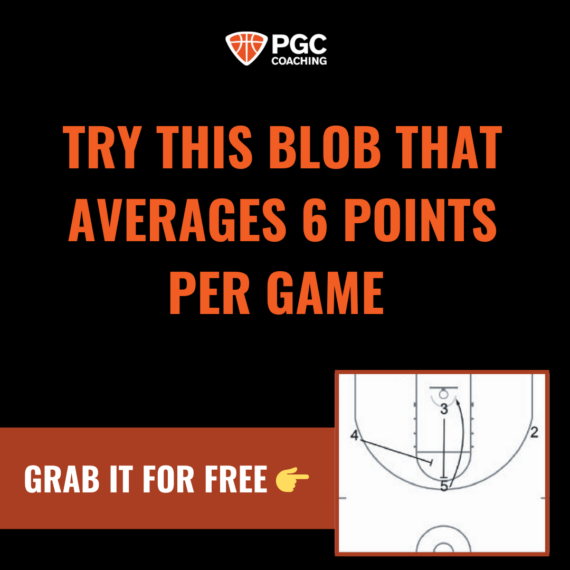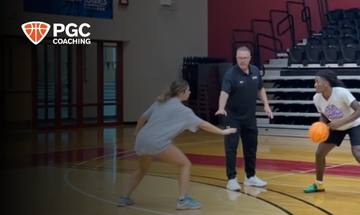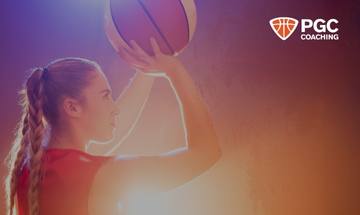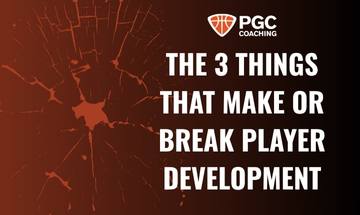What Does It Mean to Win the Workout?
That’s the question I posed at the beginning of a recent practice.
If you’ve spent any time coaching, you’ve probably asked yourself some version of it too: How do I help my players get better?
After more than 20 years of coaching and making just about every mistake in the book, I’ve found a few basketball player development principles that transformed how I develop basketball players.
And today, I’m going to share the top 5 with you.
Whether you’re working with one player or an entire team, these 5 principles will help you run more intentional workouts and make every session count.
If you’re like most coaches, you can never have too many player development drills in your arsenal. Here are a few more you might enjoy after diving into this blog:
- 5 Passing Drills to Build Tough, Smart, and Unselfish Basketball Players
- 5 Game-Like Basketball Shooting Drills to Build Confident, Consistent Scorers
- Basketball Rebounding Drills to Build Toughness & Game-Winning Habits
The Teacher Analogy Every Coach Needs
Think back to your days as a student. There was a big difference between the teacher who hit play on a video and the one who taught you something. It wasn’t just the content that made the good ones stand out—it was how they delivered it. They adjusted their style based on the learner…and they cared.
Coaching works the same way. We’re not just delivering drills. We’re teaching. And we’ve gotta think like elite educators to win the workout.
These basketball player development principles will help you make every session more effective and more transferable to the game.
1. Sufficient Reps Matter More Than the Drill
Most workouts don’t have enough reps to create real improvement.
When you’ve got 15 players and just one ball, with 14 standing in line, it’s easy to see that development isn’t happening. Too often, players are simply waiting their turn, without actually getting enough hands-on practice to make a difference.
The result? Limited progress.
The solution? Meaningful reps that refine technique and build muscle memory.
Here’s a few ideas for you:
- Use your time and space wisely: If you have multiple baskets, take full advantage of them. Don’t have enough basketballs? Pair players up so they can pass and work in tandem.
- Small groups: Work in smaller groups whenever possible. This creates a more focused environment, where players can get direct attention and more touches in less time.
- Partners: Partnering players up helps with decision-making, quick thinking, and collaboration.
This principle is foundational in nearly every set of effective basketball player development principles.
2. Suitable Level of Challenge for Every Player
One of the most overlooked basketball player development principles is appropriately challenging each athlete.
Here’s the dilemma: You’ve got one elite player and one who’s barely hanging on in the same drill. What do you do?
Most coaches aim for the middle, assuming that a drill set in the “middle ground” will challenge everyone. But this approach misses the mark. Your best player will breeze through unchallenged, while your weakest player will struggle.
If you want every player to improve, you must modify the task to suit each player’s skill level.
Here’s how:
- Use Constraints: For an elite player, you might limit their movement, reduce their time to make decisions, or put them in a more complex situation to push their decision-making and skill level. For a player who is struggling, simplify the task. Allow them more time or space to execute the fundamentals before adding extra layers of complexity.
- Personalize Goals: Provide every player with clear goals tailored to their skill level. The elite player might focus on mastering the skill at a faster pace or adding more variety to their moves, while the player who’s struggling can focus on executing simpler, foundational skills.
3. Simulate the Game—Don’t Just Run Drills
This is consistently one of the biggest challenges for coaches: practices don’t translate to game time.
Why?
In most cases, the drills being used are not game-like.
And practices must do more than teach players a new skill; they should help players execute that skill in the fast-paced, high-pressure environment of a game.
Here’s how to do it:
- Add Defenders: Make a drill more realistic with defenders. This forces players to not only focus on their technique but also make decisions based on pressure and unpredictability.
- Use Constraints: Come game time, players are constantly under pressure. Whether it’s time, defensive, or situational pressure, practices must recreate those conditions. For example, add a shot clock, a limited number of dribbles, or even a rush to execute a play. This helps players sharpen their skills and decision-making on the fly.
- Build Habits: Focus on building skills and mental approaches that players can trust in game situations. Whether it’s understanding spacing, reading the defense, or making quick decisions, you’re training players to act instinctively when the clock is ticking and the crowd is roaring.
4. Build Progressions That Progress
Too often, we throw a drill at a player, hope it sticks, and move on. But the best development happens in layers. This layered approach breaks skills down into manageable chunks and gradually increases the difficulty. This not only helps players master the fundamentals but also builds their confidence and competence.
Here’s an example of how to build a progression
- Step 1: Teach how to jump stop
- Step 2: Add a dummy defender
- Step 3: Go live and compete
At PGC, we call this approach TLC—Teach, Learn, Compete. It’s a simple framework to ensure players don’t just learn how to do something, but also why and when to apply it in a real game.
Progressions are a hallmark of well-structured basketball player development principles because they ensure continual growth.
5. Create Spacing for Memory
Learning sticks when spaced out over time. Repetition at intervals helps solidify skills.
So as coaches, if we want players to grasp the concepts we’re teaching, we need to structure practices to revisit key concepts over time. This doesn’t mean repeating the same drills endlessly; it means introducing spaced intervals of practice where players revisit concepts at varying frequencies to reinforce them in their memory.
Spacing is one of the most research-backed basketball player development principles—and one of the easiest to implement with planning.
Here’s how this works in practice:
- Start with High Frequency: When a player first learns a skill, you need to reinforce it early and often. Start by running drills or teaching concepts frequently in the first few practices. This helps the player gain a basic understanding and helps embed the skill in their muscle memory.
- Slowly Space Things Out: Once the player is familiar with the skill, you can begin spacing out the drills over time. The goal is to gradually reduce the frequency but still maintain consistent reinforcement. Over time, the skill will become ingrained, and players will recall it more instinctively during games.
- Revisit with Built-In Spacing: In my system, we incorporate this concept by revisiting skills with 1-minute drills or quick, focused repetitions that fit naturally into the flow of practice. These mini-practice sessions allow players to build on their previous knowledge while avoiding mental fatigue.
- Build Consistency and Confidence: Spacing out the drills not only strengthens memory retention but also builds confidence. By revisiting the fundamentals regularly, players know they’ll have the chance to fine-tune their skills without feeling like they’ve been “left behind.”
BONUS
It’s no secret that player development is the biggest challenge coaches face. If you’re working to develop your players consistently, then you already know how much effort it takes to get real results. STAGES, the Ultimate Online Basketball Player Development Program, is here to help you solve that problem. Think of it as your player development coaching assistant, working for you around the clock by:
Think of it as your assistant coach, helping you:
- Pinpoint each player’s skill level
- Customize drills to accelerate growth
- Track progress year-round
STAGES is built to streamline your player development, providing personalized progression that helps players move from where they are to where you need them to be.
Try our 15-day FREE trial and start implementing these core development principles with confidence.
Final Thoughts
If you can walk into any workout, whether it’s one player or 15, and ask:
- Are they getting enough reps?
- Is this the right challenge?
- Does this simulate the game?
- Are my progressions layered and intentional?
- Am I creating space for learning to stick?
… then your basketball player development principles are going to pay off with real growth.
TJ
Check out all of our PGC Player Skill Development resources by clicking here.
About the Author
TJ Rosene
Coach TJ Rosene, head coach of the Emmanuel University men’s basketball team and Director of Coach Development for PGC Coaching, has spent his career shaping young athletes both on and off the court. With over 400 career wins and 12 seasons of 20+ wins, Rosene’s coaching experience is extensive and impressive.
His teams have competed in six national championship games, winning three NCCAA National Championships. Under his leadership, the Lions made their NCAA Division II debut in 2018-19 and quickly captured two season titles and one tournament title, along with an appearance in the NCAA Division II Sweet 16 in 2021.
Rosene’s success expands far beyond the scoreboard. He’s been named National Coach of the Year three times and Conference Carolinas Coach of the Year twice. But for Coach Rosene, the most meaningful part of his work is the lasting impact he has on his players’ lives. As he puts it, “Coaching is a rare opportunity to shape and mold the lives of young people. It’s a privilege that I never take for granted.”







Share This Post